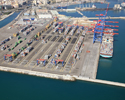
Container Terminal Employs IP Video Surveillance
IndigoVision’s complete end-to-end IP video solution is behind a sophisticated monitoring system at a container terminal in the Port of Malaga, Spain.
The completely IP-based system uses video surveillance, audio PA/intercoms, analytics and integration with access control to provide the port with site-wide security and support for its logistics operation. The facility covers 500,000 square yards and can accommodate the largest type of container ships in a 2,370 feet long, 52 foot deep berth. The IP Video system was installed by port security specialist Enyca, with equipment and design support provided by IndigoVision’s Authorized Partner, Ralco Networks.
The new system has delivered cost savings across the operation as Jorge Martín, Technical Director & Port Facility Security Officer, explains, “In addition to providing all round security, the surveillance system has transformed our operations. It enables us to better organize our employee shift patterns, investigate health and safety breeches, resolve labor disputes and most importantly monitor and track container shipments, providing video evidence in the event of any customer claims. All of these have helped us to reduce costs.”
IndigoVision’s de-centralized open architecture provides the container terminal with a flexible and scalable system, which not only benefits their current operation but was also key to providing a secure environment during construction. All components, including cameras, video recorders and video management workstations can be located at any point on the network, allowing them to be easily repositioned as necessary through the various construction phases.
The system can also transmit high-fidelity synchronized audio alongside the video. Enyca used this feature to deploy IP-based communications at the access points to the terminal. When an arriving truck driver presses a button, which is connected to a digital input in the IndigoVision transmitter module, an audio link is established with the operations centre. Operators can then relay instructions to the driver for the safe drop off or collection of their containers. The operators also use the Public Address facilities in ‘Control Center’ to broadcast pre-recorded messages and free speech to camera-mounted speakers on the poles and cranes, to manage operations and issue warnings in the event of an incident.
Workstations running ‘Control Center’, IndigoVision’s Security Management Software, are distributed around the facility in the security access control room, main operations centre, planning department and in the Director’s offices. These allow operators to monitor live and recorded video from the 40 PTZ and fixed cameras. The cameras are mounted around the perimeter, at the access points to the facility and on poles and cranes to monitor container movements. All the cameras are high-performance analog units connected to IndigoVision’s transmitter modules, which convert the camera feed to DVD quality digital video for transmission over the network.
“By mounting the cameras at a number of fixed locations and on the mobile cranes allows us to monitor and record container movements from a number of different angles.” Martín said. “This ensures we have ample evidence in the event of a customer dispute. High-quality video clips can easily be exported from the system for external analysis and investigation.”
Using IndigoVision’s extensive integration capability, Enyca’s "GISA" access control system is seamlessly integrated with the IP Video system across the network. This allows events or alarms in the access control system to trigger actions in ‘Control Center’. For example, an access alarm can automatically move a PTZ camera to a pre-configured position, display that camera on a spot monitor and identify its location on an interactive map.
Real-time analytics built into IndigoVision’s transmitter modules are being used to enhance perimeter security. The virtual trip wire analytics function has been configured on several fixed cameras monitoring the perimeter. If an object crosses the trip wire then an alarm is raised in ‘Control Center’ and operators are automatically alerted.